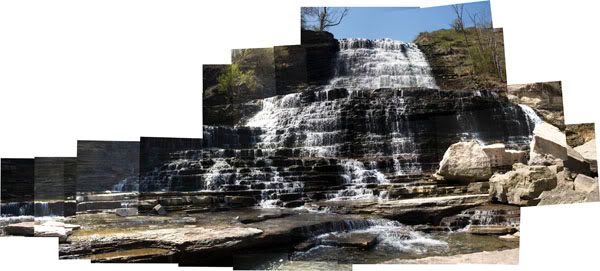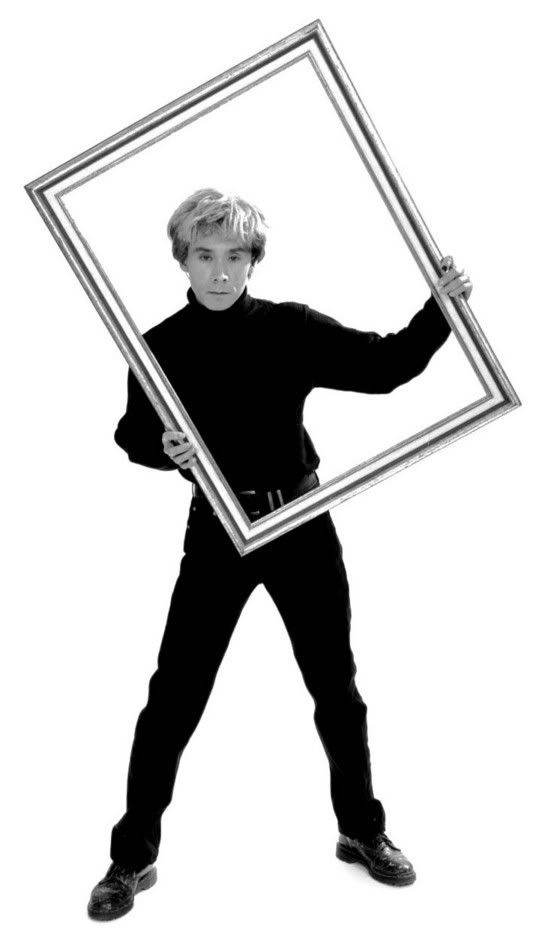Adventures of Captain Obvious
Thursday, May 5, 2011
Wednesday, December 15, 2010
Final Thoughts on AED 200
1. What were you expectations for this course and where they met?
My expectations were to expand my appreciation and knowledge of art, and my expectations were far exceeded. It is hard to get enough interaction out of an online class, especially for art. The assignments were well thought out, challenging at times, and expanded my capabilities for appreciating art.
2. Now that you've been through this course, What is art? How would you define it now compared to your initial posting?
Art is expression of ones interests, emotion, feeling, and thoughts. It's beauty is in the eye in the beholder and there is no right or wrong way of doing it. The possibilities are endless. I would define it as very complex, having many dimensions, and meaning, versus "just art".
3. Who was your favorite artist in your original posting and who is your favorite visual artist now? If there is a difference, why do you think so? If you have the same favorite artist, why do you think so?
I would say my favorite artist is still the same. MC Escher and Kincade of course! For the same reason they are my favorites. I can stare at their works forever and can immerse myself in the world of the work.
4. Now that you've completed this course, how do you feel about taking an online course? Is your answer the same as it was in your first posting? How is it the same or different?
This course was very enjoyable and it encourages me to take another next semester. I have taken a few online course, and they are conveina
My expectations were to expand my appreciation and knowledge of art, and my expectations were far exceeded. It is hard to get enough interaction out of an online class, especially for art. The assignments were well thought out, challenging at times, and expanded my capabilities for appreciating art.
2. Now that you've been through this course, What is art? How would you define it now compared to your initial posting?
Art is expression of ones interests, emotion, feeling, and thoughts. It's beauty is in the eye in the beholder and there is no right or wrong way of doing it. The possibilities are endless. I would define it as very complex, having many dimensions, and meaning, versus "just art".
3. Who was your favorite artist in your original posting and who is your favorite visual artist now? If there is a difference, why do you think so? If you have the same favorite artist, why do you think so?
I would say my favorite artist is still the same. MC Escher and Kincade of course! For the same reason they are my favorites. I can stare at their works forever and can immerse myself in the world of the work.
4. Now that you've completed this course, how do you feel about taking an online course? Is your answer the same as it was in your first posting? How is it the same or different?
This course was very enjoyable and it encourages me to take another next semester. I have taken a few online course, and they are conveina
Sunday, December 12, 2010

Roy Lichtenstein 1962
'Head - Red and Yellow'
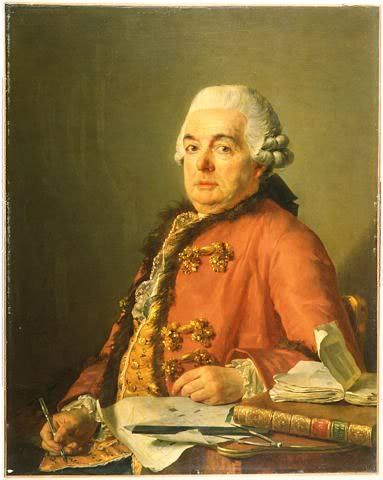
Jacques-Louis David French, 1748-1825
Portrait of Jacques-François Desmaisons, 1782
Oil on canvas, 36 x 28 1/2"
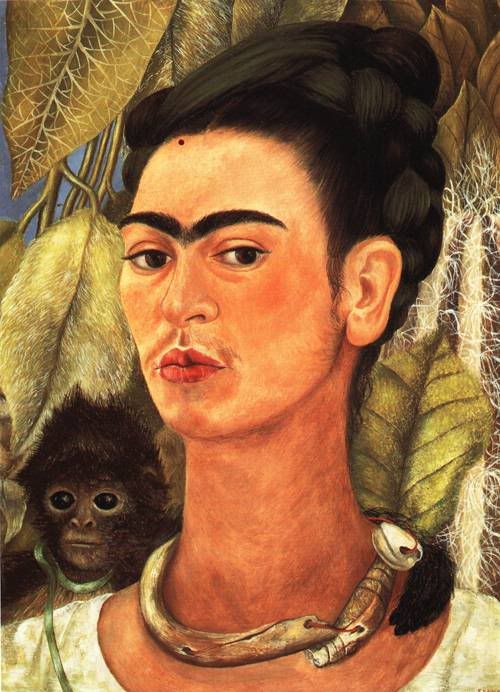
Frida Kahlo
(Mexican, 1910-1954)
Self-Portrait with Monkey, 1938
Oil on masonite, 16 x 12"
When creating my self portrait, I selected the above pieces because I was very limited to my choices, but these were solid works to establish the groundwork for my project. I like the challenge of Digital Photo, especially when your completely changing the look and mood of the photo. A basic photo is so rough and flawed in it's natural format. The cropping is off, contrast, and there are flaws in the background and other distractions. I created a new portrait from an old one. The biggest challenge was removing the picture in the background completely. It took me a while and took a lot on "undo" clicks! The piece represents me by the cool calm mood it creates. I have a very laid back personality and it reflects this. I was hoping to make such a generic photo turn into a living piece of art, and I succeeded!



Friday, December 10, 2010
Reviewing Lindsey Kostelny's Art Curator Exhibit
I recently composed an article on an art curator project called “Surrealism” by Lindsey Kostelny. I selected her exhibit mainly on my interest and inspiring feeling of Surrealism. I am also a fan of Salvador Dali, and I felt she picked other works similar to his, or that may just be my biased perspective! I wanted to be positive on my critiquing of her exhibit, but I also wanted to be very constructive. I think the presentation is just as important as the artwork incorporated in them. Detail should be paid attention to in the layout as it affects the presentation of the artwork. If you’re going to walk a hot date down the isle, you better be look just as good! I felt okay about critiquing my classmate, but I also felt apprehensive and careful about my wording, but this is something that should be done with any article. You should always choose your words carefully and politely when giving good constructive criticism. I would rate my article as a 10 of course, being that I am writing an article to keep someone’s attention and satisfy someone’s interest in what they are reading. I put a lot of feeling and passion in the article and felt I gave a good critical review of the presentation. I did enjoy working on this project, and I felt I picked a great presentation and it was well thought out on chosen art works. I enjoyed each piece and the curator’s perspective of their elements and principles.
Wednesday, December 8, 2010
Week 15 Video Review

Greenberg on Art Criticism: An Interview by T. J. Clark
Art criticism is all about being relevant and one of the hardest things to critique. Music has rules, where art doesn’t. You can hold music to a score, but art you can’t it’s relevant to taste. This helps with my project, as it will help me to focus on what is relevant, and to portray what I see and not to formulate an opinion, but to be observant. Greenberg is a multitalented individual who was artistic and a writer. It was very interesting to learn how to critique from a writer and artist, who walks both side of the fence. As an artist he can put art into words.
Greenberg on Pollock: An Interview by T. J. Clark
I did not know Pollack did not like easel painting, and he believed easel paintings had no beginning and end. They were just a portion or partial of the full idea or work. It was funny to learn Greenberg takes credit for this idea. I don’t feel this relates to my project, as other than the diversity of Pollock's works. I did get more of and understanding of whom Pollack was, his frustrations, and his different styles. I like Jackson Pollock’s works, so I thoroughly enjoyed getting to know more about him.
An Introduction to the Italian Renaissance (Giorgio Vasari)
Giotti was one of the first painters to use perspective, as he used backgrounds and foregrounds in hi painting. He was very enthusiastic about nature and wanted to include it in his works. Although he didn’t make everything perfect, to scale, or realistic, he started the trend. The video helped me to recognize style and influence in art when I critique it. I need to recognize style and how they make it unique, and not just form a biased opinion whether I like something or not. This was a great film that directs attention towards style and different individualism of each artist. I liked the nonbiased criticism and the different aspects the art was viewed with.
The Critics: Stories from the Inside Pages
I learned critics get us to think, when I figured they just liked to argue or get a rise out of someone. It makes sense though, for example a witty political cartoon bashing a policy. It’s an indirect way of voicing an opinion, and making others wonder why or what if it was true. Not only do they attack in a sense, they can protect or even boost someone. For example they could highlight a music performance giving publicity and thus boosting their popularity with a crowd. Of course whatever I critique, I will want to boost, praise, and promote. I am going to pick something that I have interest in and hopefully praise it, and maybe that will be contagious enough for someone else to do the same.
The Colonial Encounter: Views of Non-Western Art and Culture
I have never heard of Dahome, or seen any of their artwork or craft as some refer to it, until now. They were very skilled, detailed, and accurate in their repetition of patterns and scale. I am not looking at art exhibiting African cultures, but understanding more of another culture’s craft, can open you up to understanding another’s. So it may help in this manner! I think this film was very informative and interesting to see the three different African arts and how important they are to these cultures and the rest of the world.
Jackson Pollock: Michael Fried and T. J. Clark in Conversation
I knew Jackson Pollock was phenomenal, but I did not know his influence was this great according to the video. I was also amazed by some of the conflicting opinions of some of his works. I liked the cross-criticism and the depth of the two critics featured in the video. I liked listening to their critiques and how detailed and well they spoke of Pollock’s works. I think it gave me some new perspective on criticism and will definitely help me in my review.
Wednesday, November 24, 2010
Week 13 & 14 Video Review


The video on George Easton was very informative and interesting as photography is a hobby of mine, and I find it interesting to see others compositions and strategy. It was neat to learn the history of the father of the photo. I had no knowledge of the George Eastman House until today, and I would love to tour it. I would love to see the Iwo Jima photograph and all the cameras. I will definitely have photography in my project, as it is one of my favorite subjects of art. Very good film, and I liked the presentation and the narrator wasn’t sleepy. Very good history lesson and cinematography, I was engaged throughout the entire film.
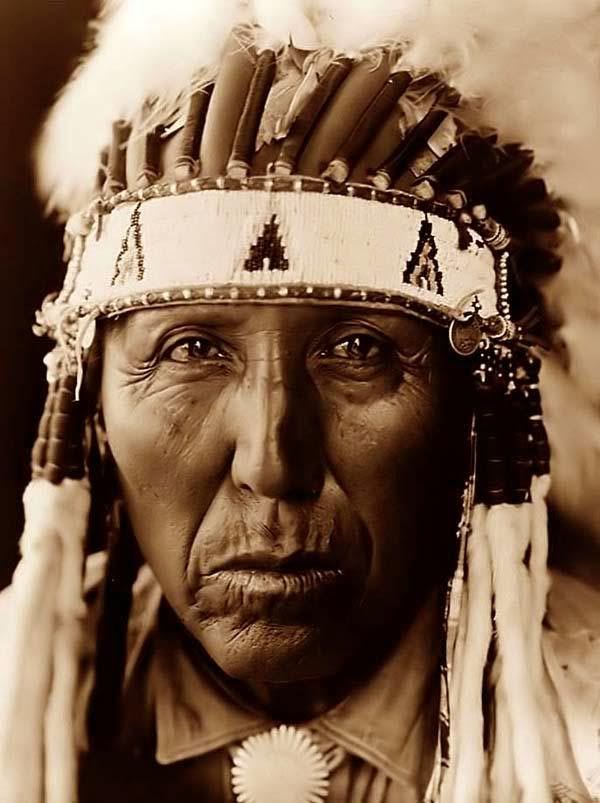
Native American Archaeology was a very enlightening vide, as I have known from history the oppression of the Native Americans, but also they were being exterminated, similar to what the Nazis were doing to the Jews. It’s amazing how hypocritical it can be how we remember the Holocaust, but we do not recognize Genocide in our own country, its ironic the Germans are the same way about the Holocaust. I just can’t believe with how much compassion we have for the Jews, we have a lack of compassion for the American Indians. It’s interesting still how much tension and confrontation there still is with Native American Culture. From what I was able to view of the film I think it’s sad that the Indians still get a lack of respect and are still pushed around.


Displaying Modern art is more complicated than I thought, and seems like there is as much planning involved in displaying the work as there is in creating it. I figured there was quite a bit of planning involved in art, but never knew there was this much detail. It makes sense after watching the video how much careful planning there is, and how important the environment is to the art work and vice versa. They should complicate each other. I am not too interested in Modern Art, so I am not planning to I include it in my project. This video was a little dry for me, but I’m not sure how exciting it could possibly be. It was very interesting to see the transition of modern art from being hung on the wall, to coming off the wall.

I learned what Lowbrow art was. I like the fact that it is reactionary to highbrow art, meaning there is no color scheme, organization, or any kind of format followed. Most Lowbrow artists don’t even like the term, because they don’t label their art. It originated from pictures of hot rods and naked or scantily clad women. After watching this video I would like to look into and maybe include some lowbrow works into my project. This was definitely a cool film, and I liked the lack of dryness and inventiveness in the artists and their work. There were a variety of interesting works and I am interested in learning more of this art form.
Friday, November 19, 2010
Week 12 Video Blog
Hockey used photography to take pictures of things that represented a painting. E would take the images and cut and arrange them in a manner where it represented a painting. I like and learned that you could take images and arrange them on a large scale to recreate an art or in Hockney’s mind a painting. Being a photographer I learned you can create an art out of multiple pictures. I also learned Hockney invented the Polaroid, something which I don’t remember reading in the text. I was actually inspired by his form and would like to take on some photo collages myself.
I always thought Andy Warhol was a rich and interesting individual, so I chose to watch a video on him to learn more about him. From the text I know him as controversial from his ads, to photographing things like race riots. I learned he favored silk screen because there was literally no work in it at all. His associates could also duplicate these arts without him. I learned also how he integrated painting into his silk screens. It was very interesting to get inside Andy Warhol’s head, and his thought processes behind his works. I came away with knowing who Andy Warhol was and what he strive to do. I like how he said, “If you want to know Andy Warhol, simply look at the surfaces of my paintings and arts.”
Rothko is not an artist I’m very familiar with, so I was interested in watching the video on him. It was very intriguing hoe he died as his paintings were arriving at a London gallery. I liked his ideals in that art could save the world. The text did not tell how he defected to the US and its capitalistic ways from Russia, where he was offered a substantial amount of money. His art was inspiring and proved to be in great demand by the public. It was interesting to learn he did not appreciate the commissions he received and despised the amount of money that could be made in such a Capitalist society. I liked how he painted murals for a restaurant hoping to make its diners sick, as he hated the rich.
Isamu Noguchi is very interesting where self expression does not interest him, space, time, and looking for a design or image in an object is what he appreciates. The text did not infer that his inspiration was from Japanese Gardens, and from this he refers to his sculptures and spaces as gardens. It’s a place that can only be created with observance and time. This is the model he used and was very interesting and Zen- like. I appreciated his water sculptures and their different design and thought processes in creating them. He used time and observance to envision the different works, and the video was very in depth about his process.
Subscribe to:
Posts (Atom)
